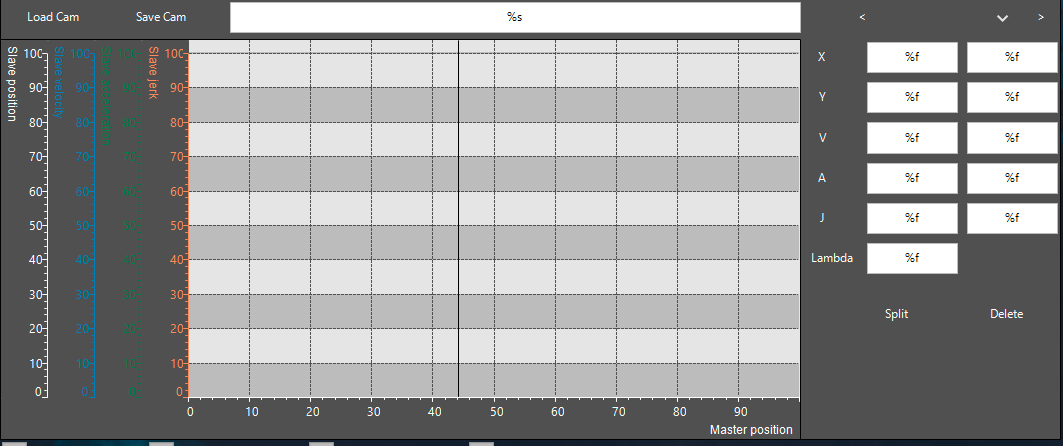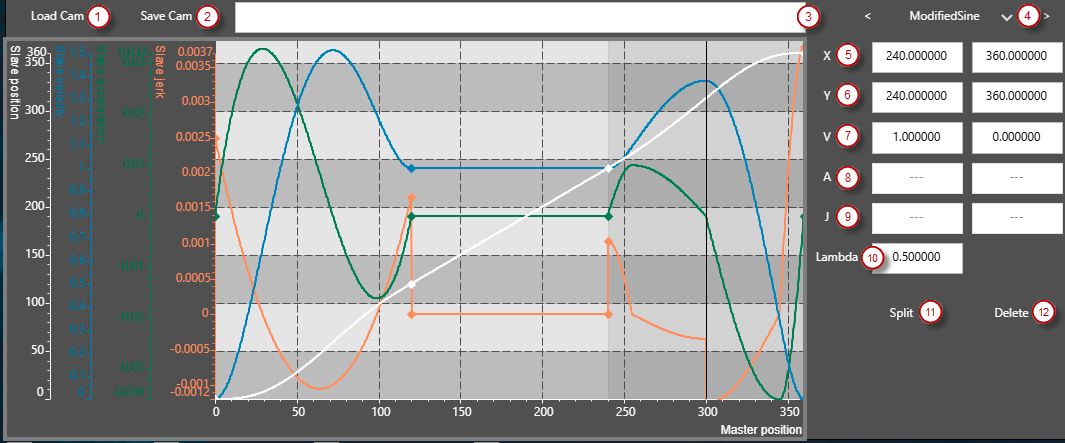Visualization Element: Online Cam Editor
The online cam editor is a visualization template that displays a cam in the visualization. With this element, you can modify the cam in online mode.
The visualization element is made available in a visualization template (SMC_VISU_CamEditor) of the SM3_Basic_Visu library. You find it in the visualization editor in the Toolbox view in the SM3_Basic_Visu tag.
The SMC_Visu_CamEditor is inserted into the visualization via a frame.
For more information about this visualization element, see: Visualization Element: Frame.

In addition to the properties of the frame element, this template contains the following properties:
Property | Description |
|---|---|
safeCam | Reference to the cam to be edited |
showPosition | Boolean variable for toggling the display of the position curve on and off |
showVelocity | Boolean variable for toggling the display of the velocity curve on and off |
showAcceleration | Boolean variable for toggling the display of the acceleration curve on and off |
showJerk | Boolean variable for toggling the display of the jerk curve on and off |
showSelectedSegment | Boolean variable for toggling the highlighting of the selected segment on and off |
The cam to be edited is transferred via an instance of the SMCB.CAM_REF_MULTICORE_SAFE function block.
PROGRAM PLC_PRG VAR safeCam : SMCB.CAM_REF_MULTICORE_SAFE; END_VAR
Cam editor in online mode
In online mode, the individual segments of the cam can be selected in the graph. The segment editor on the right-hand side can be used to add and delete segments, as well as to adapt the boundary conditions of the selected segment.

(1) Load Cam | Loads the configured cam into the editor |
(2) Save Cam | Saves the edited cam |
(3) Status bar | Displays status messages |
(4) Segment selection | A segment can be selected using the arrows. The segment type can be changed via the list box. |
(5) Master position | The master position on the left and right edge of the segment |
(6) Slave position | The slave position on the left and right edge of the segment. |
(7) Slave velocity | The slave velocity on the left and right edge of the segment. Not editable for all segment types. |
(8) Slave acceleration | The slave acceleration on the left and right edge of the segment. Not editable for all segment types. |
(9) Slave jerk | The slave jerk on the left and right edge of the segment. Not editable for all segment types. |
(10) Lambda parameter | Lambda parameter for the modified sine line. |
(11) Split | Divides the selected segment into two segments. |
(12) Delete | Deletes the selected segment. |
Using a created cam in the application
You can use the cam created with the SMC_Visu_CamEditor visualization element in the application by calling the GetCopy method of the CAM_REF_MULTICORE_SAFE instance.
PROGRAM PLC_PRG
VAR
safeCam : SMCB.CAM_REF_MULTICORE_SAFE;
camRef : MC_CAM_REF;
camSegments : ARRAY[0..99] OF SMC_CAM_SEGMENT;
error : SMC_ERROR;
END_VAR
IF safeCam.CamId <> oldCamId THEN
error :=
safeCam.GetCopy(
camRef:= camRef,
pCamSegments:= ADR(camSegments),
arraySize:= XSIZEOF(camSegments));
oldCamId := safeCam.CamId;
END_IFThe program first checks whether a new cam has been created (CamId <> oldCamID). If so, then a copy of this cam is created using the GetCopy method. If the call returns SMC_NO_ERROR, then the camRef instance of the MC_CAM_REF function block can be used with the SoftMotion cam function blocks MC_CamTableSelect and MC_CamIn. The GetCopy call is task-safe and therefore does not have to be made from the Visu task.